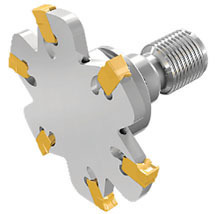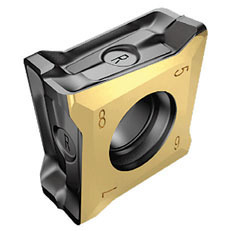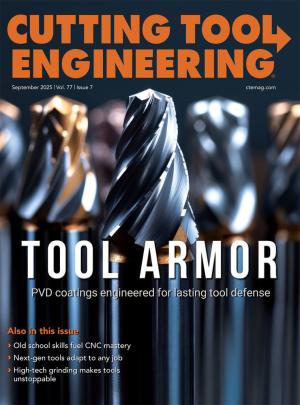Being productive while maintaining consistency is paramount for success in manufacturing, but process variables related to the various manufacturing technologies in use — such as machines, material, part geometry and cutting tools — often seem to throw a wrench into metalworking success. When you think about cutting tools and all the process variables that come into play (machine, material, material hardness, part fixturing, type of toolholder, gauge lengths, cutting parameters, etc.), it’s of no surprise that a large percentage of cutting tools put into use are misapplied and/or underutilized. This is where interchangeable, indexable and a combination of the two (interchangeable- indexable) cutting tool systems can be applied. Engineered to be versatile, efficient and repeatable, these highly adaptable cutting tool systems offer powerful solutions for taking on manufacturing’s most persistent challenge — dealing with process variables.
This article will outline the difference between interchangeable and indexable cutting tools, and how these once mutually exclusive systems have been combined (e.g., interchangeable- indexable) to offer the advantages of indexable insert tooling and provide maximum customization and optimization towards various machining processes.
To set the stage, let’s start with basic definitions of indexable and interchangeable tool types, which are often confused with one another, so that readers can delineate between the two.
Indexable Cutting Tool: A cutting tool consisting of a body (typically made of steel) that incorporates mechanically clamped replaceable inserts (made of cemented carbide, ceramic, etc.) that can be rotated/ flipped multiple times or swapped as needed.
 Typical indexable cutting tools/inserts. image: Iscar
Typical indexable cutting tools/inserts. image: Iscar
Interchangeable Cutting Tool: A cutting tool consisting of a holder/ body (steel, carbide, heavy metal) and interchangeable head attached to the shank with various, sometimes proprietary, methods (e.g., threaded connection, mechanical clamping, self-tightening mechanical pocket).
 MULTI-MASTER system and solid carbide interchangeable head. image: Iscar
MULTI-MASTER system and solid carbide interchangeable head. image: Iscar
Indexable Insert Trends
Coatings & Materials: Coating enhancements are a consistent pursuit and continue to provide nice gains in productivity, especially for those companies that haven’t pursued pursued any improvements in a few years.
Substrate enhancements and more exotic insert materials such as ceramics and CBN/PCD inserts with chip formers are becoming more prevalent and improving productivity of difficult to machine materials/ applications, such as machining nickel-based super alloys (Inconel) and heat-treated (hardened) materials.
Higher Precision/Repeatability: Modern powder compaction presses provide extremely tight tolerances and precise control of the pressing cycle. This control in the first phase of insert creation leads to a higher performance on the machine.
Integrated Insert Geometries: Multi-axis/level pressing and complex die sets enable the creation of complex inserts in a single pressing, such as double-sided or multisided inserts (i.e., inserts with more cutting edges) with pressed in chip forming geometry or other features such as coolant grooves.
 Shown is the LOGIQTANG insert. image: Iscar
Shown is the LOGIQTANG insert. image: Iscar
Micro-Inserts/Tooling: The modern pressing technology previously outlined provides the process control needed to create tiny inserts with geometry while maintaining the attributes and overall quality required of a sintered carbide insert. By coupling the ability to press tiny inserts with 3D metal additive technologies to create the cutter body, you now have an expanded range of indexable cutting tools — with coolant thru capability to smaller diameters (1/4", 5/16", 3/8", etc.) — that previously could only be served by solid carbide tooling.
 Shown is ISCAR’s nano endmill, the NANMILL. All images: Iscar
Shown is ISCAR’s nano endmill, the NANMILL. All images: Iscar
Evolution of Interchangeable Cutting Tools
Interchangeable cutting tool designs have been in play for many decades and have long been known for providing the versatility to adapt a cutting tool assembly to the task at hand. These early/ simple systems consisted of steel bodies and interchangeable steel heads possessing indexable inserts. Of course, there are inherent disadvantages of an interchangeable system, due to added connections, that reduce rigidity/accuracy and lead to reduced performance/ productivity. Some argue there’s an additional cost due to needing additional components to make a cutting tool assembly, but this is usually a short-sighted viewpoint that neglects to consider the lifecycle of their investments. If the interchangeable system is being applied correctly, the initial purchase price of the interchangeable tooling quickly reaches a breakeven point and overall cost savings are realized.
But enough about money, let’s get back to the technical. As just mentioned, the disadvantages of early interchangeable systems — a reduction in rigidity/accuracy — are mainly due to the connection and tool types that are applied. This “connection point” is where next generation interchangeable cutting tools have drastically improved and changed the game.
Enter Advanced Interchangeable Heads
Starting in the late 1980’s and early 1990’s, cutting tool manufacturers introduced more advanced interchangeable systems that incorporated solid carbide interchangeable heads, and the main benefit — besides the versatility of head adaptation — was the connection types that drastically improved accuracy/ rigidity of a modular system. For ISCAR, the MULTI-MASTER system connection incorporated a ground threaded connection, including conical taper and face contact, that has a slight interference fit when connected to a shank. The accuracy and ease of use provided by this system/connection introduced in the early 1990’s left little room to improve. That said, few people likely imagined the sheer number of possibilities/combinations (i.e., versatility) that would be added to these interchangeable systems over the years. And the additions being made to this day continue to push versatility to new heights.
Adding Indexable Heads
In recent years, these interchangeable systems have been further augmented with the introduction of interchangeable-indexable heads. This provides users with the inherent cost benefits of indexable inserts along with the added versatility of customizing the interchangeable head and its indexable inserts (geometry/grade) to the material and part geometry at hand.
Aligning With Manufacturing Trends
Consider some of the manufacturing technology trends that have emerged in recent years, such as:
- CNC machines being lighter duty with higher RPM capability but less HP;
- additive technologies or near net shape forgings and casting requiring less material to be removed with traditional roughing operations/tools;
- CAM toolpath algorithms that allow for more efficient trochoidal toolpath approaches utilizing higher speed to make metal removal gains.
It’s of no surprise that today’s advanced interchangeable cutting tool offerings are becoming the go-to solution, replacing many solid carbide tools or traditional type indexable tooling. The recent additions of advanced interchangeable- indexable heads opens the door to many new applications that users can leverage in terms of versatility and in outfitting their indexable tooling with the latest indexable insert designs, optimized grades/coatings and geometries that can make a difference in maximizing productivity from job to job — no matter the variation at hand.
Related Glossary Terms
- alloys
alloys
Substances having metallic properties and being composed of two or more chemical elements of which at least one is a metal.
- ceramics
ceramics
Cutting tool materials based on aluminum oxide and silicon nitride. Ceramic tools can withstand higher cutting speeds than cemented carbide tools when machining hardened steels, cast irons and high-temperature alloys.
- computer numerical control ( CNC)
computer numerical control ( CNC)
Microprocessor-based controller dedicated to a machine tool that permits the creation or modification of parts. Programmed numerical control activates the machine’s servos and spindle drives and controls the various machining operations. See DNC, direct numerical control; NC, numerical control.
- computer-aided manufacturing ( CAM)
computer-aided manufacturing ( CAM)
Use of computers to control machining and manufacturing processes.
- coolant
coolant
Fluid that reduces temperature buildup at the tool/workpiece interface during machining. Normally takes the form of a liquid such as soluble or chemical mixtures (semisynthetic, synthetic) but can be pressurized air or other gas. Because of water’s ability to absorb great quantities of heat, it is widely used as a coolant and vehicle for various cutting compounds, with the water-to-compound ratio varying with the machining task. See cutting fluid; semisynthetic cutting fluid; soluble-oil cutting fluid; synthetic cutting fluid.
- endmill
endmill
Milling cutter held by its shank that cuts on its periphery and, if so configured, on its free end. Takes a variety of shapes (single- and double-end, roughing, ballnose and cup-end) and sizes (stub, medium, long and extra-long). Also comes with differing numbers of flutes.
- hardness
hardness
Hardness is a measure of the resistance of a material to surface indentation or abrasion. There is no absolute scale for hardness. In order to express hardness quantitatively, each type of test has its own scale, which defines hardness. Indentation hardness obtained through static methods is measured by Brinell, Rockwell, Vickers and Knoop tests. Hardness without indentation is measured by a dynamic method, known as the Scleroscope test.
- indexable insert
indexable insert
Replaceable tool that clamps into a tool body, drill, mill or other cutter body designed to accommodate inserts. Most inserts are made of cemented carbide. Often they are coated with a hard material. Other insert materials are ceramic, cermet, polycrystalline cubic boron nitride and polycrystalline diamond. The insert is used until dull, then indexed, or turned, to expose a fresh cutting edge. When the entire insert is dull, it is usually discarded. Some inserts can be resharpened.
- lapping compound( powder)
lapping compound( powder)
Light, abrasive material used for finishing a surface.
- metalworking
metalworking
Any manufacturing process in which metal is processed or machined such that the workpiece is given a new shape. Broadly defined, the term includes processes such as design and layout, heat-treating, material handling and inspection.
- process control
process control
Method of monitoring a process. Relates to electronic hardware and instrumentation used in automated process control. See in-process gaging, inspection; SPC, statistical process control.
- shank
shank
Main body of a tool; the portion of a drill or similar end-held tool that fits into a collet, chuck or similar mounting device.
- toolholder
toolholder
Secures a cutting tool during a machining operation. Basic types include block, cartridge, chuck, collet, fixed, modular, quick-change and rotating.
- toolpath( cutter path)
toolpath( cutter path)
2-D or 3-D path generated by program code or a CAM system and followed by tool when machining a part.

